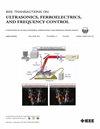Time-Sharing Acoustic Tweezers for Parallel Manipulation of Multiple Particles
IF 3
2区 工程技术
Q1 ACOUSTICS
IEEE transactions on ultrasonics, ferroelectrics, and frequency control
Pub Date : 2025-02-10
DOI:10.1109/TUFFC.2025.3540512
引用次数: 0
Abstract
Holographic acoustic tweezers have various biomedical applications due to their ability to flexibly and rapidly synthesize acoustic fields for manipulating single or multiple particles. Existing multiparticle manipulation techniques are usually realized by precisely designing the incident wave’s phase distribution to synthesize a complex and steady-state acoustic field containing multiple acoustic trapping beams. However, interference effects between multiple beams tend to produce artifacts that trap particles in unwanted positions, limiting accuracy, and the number of manipulated particles. In addition, those techniques can only holistically manipulate multiple particles, namely, lacking parallel working ability. In this study, we proposed a time-sharing acoustic tweezer method to achieve the manipulation of multiple particles by rapidly switching individual trapping beams, minimizing interference artifacts. We applied this method to a 256-element phased-array acoustic tweezer system with designed ultrasonic pulse sequences to synthesize a single focused, twin trap, and vortex beam, enabling the pseudo-parallel manipulation of multiple particles in 3-D space at a beam switching frequency of ≥10 kHz. The experiments on polydimethylsiloxane particles ranging from micrometers to millimeters in diameter demonstrated that up to 96 particles can be successfully trapped and assembled into a 2-D lattice. Different numbers of particles were also patterned into dynamic contours, such as sinusoidal vibration (ten particles) and butterfly flapping (24 particles). In addition, the trapped multiple particles can also be rotated around their respective orbits. The proposed technique improved the number of objects dynamically manipulated in a parallel manner, advancing holographic acoustic tweezers and their applications.分时声学镊子并行操作多个粒子。
全息声镊由于能够灵活快速地合成声场来操纵单个或多个粒子而具有各种生物医学应用。现有的多粒子操纵技术通常通过精确设计入射波的相位分布来合成包含多个声捕获光束的复杂稳态声场来实现。然而,多个光束之间的干涉效应往往会产生将粒子困在不想要的位置的伪影,从而限制了精度和被操纵粒子的数量。此外,这些技术只能整体操作多个粒子,缺乏并行工作能力。在这项研究中,我们提出了一种分时声镊子方法,通过快速切换单个捕获光束来实现对多个粒子的操作,从而最大限度地减少干扰伪影。我们将该方法应用于256元相控阵声镊系统,该系统具有设计的超声脉冲序列,可以合成单聚焦、双阱和涡旋光束,从而在三维空间中以≥10 kHz的波束开关频率对多个粒子进行伪平行操作。对直径从微米到毫米的聚二甲基硅氧烷颗粒的实验表明,多达96个颗粒可以成功捕获并组装成二维晶格。不同数量的粒子也被绘制成动态轮廓,比如正弦振动(10个粒子)和蝴蝶拍打(24个粒子)。此外,被捕获的多个粒子还可以绕各自的轨道旋转。该技术提高了以并行方式动态操纵的物体数量,促进了全息声镊及其应用。
本文章由计算机程序翻译,如有差异,请以英文原文为准。
求助全文
约1分钟内获得全文
求助全文
来源期刊
CiteScore
7.70
自引率
16.70%
发文量
583
审稿时长
4.5 months
期刊介绍:
IEEE Transactions on Ultrasonics, Ferroelectrics and Frequency Control includes the theory, technology, materials, and applications relating to: (1) the generation, transmission, and detection of ultrasonic waves and related phenomena; (2) medical ultrasound, including hyperthermia, bioeffects, tissue characterization and imaging; (3) ferroelectric, piezoelectric, and piezomagnetic materials, including crystals, polycrystalline solids, films, polymers, and composites; (4) frequency control, timing and time distribution, including crystal oscillators and other means of classical frequency control, and atomic, molecular and laser frequency control standards. Areas of interest range from fundamental studies to the design and/or applications of devices and systems.

 求助内容:
求助内容: 应助结果提醒方式:
应助结果提醒方式:


